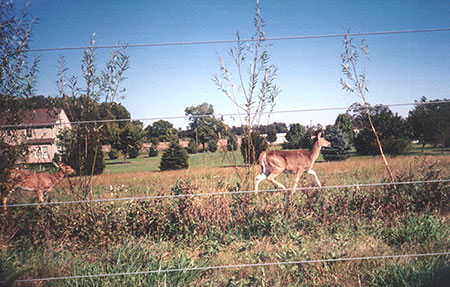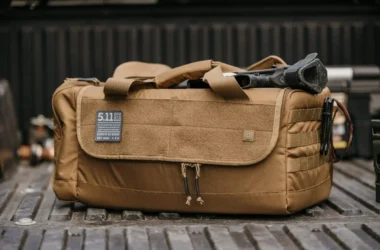A 1998 Rutgers NJAES Snyder Research and Extension Farm survey of more than 4000 New Jersey farmers (202k PDF) clearly demonstrated the economic damage caused by deer to agricultural crops. Farmers estimated between $5 and $10 million per year in crop damage.
High-Tensile Woven Wire Fencing
Farmers who grow valuable crops like vegetables, nursery plants, and fruits are the ones who benefit most from using high-tensile woven wire deer fencing, which is known for effectively reducing deer damage but can be expensive to install, costing around $10 per foot. Over the past 20 years, the New Jersey Department of Agriculture and the New Jersey State Agricultural Development Committee have sometimes provided financial assistance to farmers for installing deer fencing, aiming to support agriculture in New Jersey. Despite more than 1.2 million feet of this fencing being installed through these programs, only a small part of New Jersey’s farmland is fenced to protect against deer damage, focusing mainly on valuable crops due to the significant cost for farmers. Many farmers have taken it upon themselves to install deer fencing, driven by substantial economic losses caused by deer, which can make profitable farming challenging in certain regions. The Snyder Research & Extension Farm has played a key role by helping to develop fencing specifications, offering training on DIY fencing installation, and distributing fencing materials to farmers, contributing to effective prevention of deer damage for more than twenty years, estimated to reduce fencing costs for farmers by about 35%.
Portable electric fencing can offer farmers a practical and cost-effective solution to safeguarding their high-value crops from damage caused by wildlife. There are primarily two types of portable electric fencing: electric netting and hot tape. These fences serve not only to deter deer but also to mitigate damage from other small mammals like groundhogs and foxes (electric netting only). Effective management is essential to uphold the efficiency of these fences, as this budget-friendly option may not consistently yield desired results. Here are some detailed tips that farmers can implement to optimize the effectiveness of portable electric fencing:
- Utilize portable electric fencing on relatively smaller areas, ideally one acre or less, as this size tends to maximize the efficacy of the fences.
- Ensure that the portable charger used to electrify the fence is capable of delivering a consistent and robust electrical shock to deter wildlife effectively.
- Consider implementing a trap crop strategy, such as planting young soybeans, to divert deer away from high-value crops. Position the trap crop nearer to areas frequented by deer during the day to enhance its effectiveness.
- Enhance the visual deterrent aspect by hanging colored Mylar tape from the fence and deploying other visual elements like Mylar balloons to create a dynamic and disorienting visual effect.
Demonstrations conducted at three farms, initiated by the Snyder Research & Extension Farm, showcased the benefits of employing two rows of hot tape spaced six feet apart and positioned at a height of 42 inches on approximately half-acre sites. These demonstrations illustrated reduced deer damage compared to non-fenced areas. The underlying theory suggests that the configuration of a double row of hot tape induces visual confusion in deer, affecting their depth perception and deterring them effectively from accessing crops.
For nursery and tree fruit farmers seeking effective wildlife damage control strategies, the Snyder Research & Extension Farm has introduced a promising approach involving the planting of hybrid willows outside existing electrified fences to serve as windbreaks. Observations revealed that deer exhibit a strong preference for feeding on and rubbing against these hybrid willows, which are known for their ease of cultivation and rapid growth rates of up to six feet per year. This method aims to divert deer away from valuable nursery and orchard crops by providing an attractive alternative source of food and rubbing material.
To further investigate deer behavior and tree preferences, a demonstration was conducted to assess whether antlered deer showed a preference for rubbing against small, 1- to 2-inch caliper hybrid willow, apple, or peach trees when planted closely together. The preliminary findings indicated that deer favored rubbing against the willow trees over the other tree varieties. Nursery and orchard farmers may find it beneficial to consider planting hybrid willows as a potential strategy to mitigate deer damage to fruit trees and nursery stock, while ensuring these willows are strategically placed at a sufficient distance from valuable tree crops to effectively divert deer attention away from the main planting areas. This approach offers a natural and sustainable solution to managing wildlife damage in agricultural settings.
Conclusion
The wildlife control strategies discussed, such as portable electric fencing and planting hybrid willows as windbreaks, offer practical and potentially effective solutions for nursery and tree fruit farmers facing challenges from deer and other wildlife. These methods, demonstrated and researched by the Snyder Research & Extension Farm, highlight the importance of proactive approaches to managing wildlife damage in agricultural settings. By implementing these strategies, farmers can potentially reduce crop losses and minimize economic impacts while promoting sustainable practices that benefit both agriculture and wildlife management. Continued research and adoption of innovative techniques will be essential for addressing the ongoing challenges posed by wildlife interactions in farming environments.





